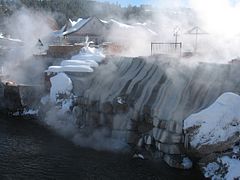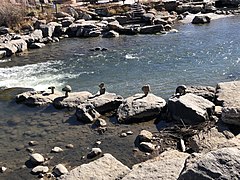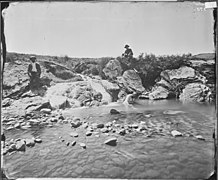Pagosa hot springs
| Pagosa hot springs | |
|---|---|
 | |
| Location | Southern Colorado |
| Coordinates | 37°16′5″N 107°1′28″W / 37.26806°N 107.02444°WCoordinates: 37°16′5″N 107°1′28″W / 37.26806°N 107.02444°W |
| Elevation | 7,126 feet |
| Type | geothermal spring |
| Temperature | 110 °F to 144 °F (62 °C) |
| Depth | 1002 feet |

Pagosa hot springs (Ute: Pah gosah) is a hot spring system located in the San Juan Basin of Archuleta County, Colorado. The town of Pagosa Springs claim they are the world's deepest known geothermal hot springs.[1][2]
History[]
Before the arrival of Hispanic and Anglo settlers, the springs were used by the Folsom culture, a 9,000 year old Folsom point was found at the site of a shelter foundation nearby. Later, the Ancestral Puebloan people used the springs, having settled at the San Juan River approximately 1,000 years ago. Shards of pottery made by the Ancestral Puebloans were found at the springs in the 1950s when a well excavation blast caused the spring water to eject undgerground material.[3] The springs were later by the modern Pueblo people, Ute, Navajo and Apache.[4][5] The hot springs were used by these indigenous people for centuries; and it has been written that they were considered "sacred ground".[6]
The springs are known to the Ute people as Pah gosah which means either "healing water" or "water (pah) that has a bad smell (gosah)", referring to the pungent odor of hydrogen sulphide gas produced by the interaction of sulphur with anaerobic bacteria in the mineral water.[7][8]
In 1859, the springs were recorded by Captain John Macomb during his exploration expedition of the San Juan area. He noted that the springs were considered a sacred site and a "place of peace" that was used by various tribes.[3] After white settlers arrived, much of the area surrounding the major spring (now known as The Mother Spring) was landfilled and walkways were constructed between springs and vapor vents.[3]
Public and private bathhouses were built for use by gold miners and families, as well as injured Civil War soldiers.[3] A commercial bathhouse was first constructed 1881, for paying customers (including European tourists) who wanted to "take to the waters".[6]
In the late 1880s, Mary Fisher, a young woman doctor of homeopathy and surgery with a degree from Hahnemann Medical School, traveled from Chicago to found a medical and healing practice in Pagosa Springs.[9]
Pagosa hot springs are the world's deepest geothermal hot spring.[10] This "Mother Spring" feeds dozens of primitive, rock-lined hot mineral water soaking pools located along the banks of the San Juan River that flows through the center of the town of Pagosa Springs, Colorado. These hot springs are free of cost and open to the public 24 hours per day. The Mother Spring also feeds developed, private soaking pools at three locations in town.[11]
Water profile[]
Pagosa hot springs are the world's deepest geothermal hot spring.[12] This "Mother Spring" feeds dozens of primitive, rock-lined hot mineral water soaking pools located along the banks of the San Juan River that flows through the center of the town of Pagosa Springs, Colorado. These hot springs are free of cost and open to the public 24 hours per day. The Mother Spring also feeds developed, private soaking pools at three locations in town.[11]
The mineral content of the waters consist of arsenic 0.12 mg/L, boron 1.8 mg/L, chloride 180 mg/L, fluoride, 4.3 mg/L iron 0.08 mg/L, lithium 2.9 mg/L, manganese 0.23 mg/L, magnesium 25 mg/L, potassium 90 mg/L, silica 25 mg/L, sodium 790 mg/L, sulfate 1400 mg/L, and zinc 0.01 mg/L.[13]
Geology[]
The Pagosa geothermal hot springs are located on the western slope of the Continental Divide. The sulfur-rich water emerging from what is called the "Mother Spring" has been measured between 110 °F and 144 °F (62 °C).[5] The water originates from 6,000 feet below the surface from volcanic activity.[14]
Gallery[]

"foot bath" hot spring San Juan River

The Mother Spring

Sulphur formation at Pagosa Springs

Hot Springs in winter

Public hot spring soaking pools along the banks of the San Juan River

Pagosa hot springs in 1874, photograph: Timothy O'Sullivan

Man Bathing in Pagosa Hot Spring, 1874, photograph: Timothy O'Sullivan
See also[]
References[]
- ^ Boster, Seth (May 21, 2018). "World's deepest hot spring also site of Colorado luxury". The Gazette. Retrieved 22 December 2019.
- ^ "Deepest geothermal hot spring measured by plumb line". Guinness World Records. Retrieved 22 December 2019.
- ^ a b c d Vance, Norm (Summer–Autumn 2021). "Cultural History of the Hot Springs". The Pagosa Magazine: 16.CS1 maint: date format (link)
- ^ "History of Archuleta County". Archuleta County Colorado. Retrieved 22 December 2019.
- ^ a b Gulliford, Andrew (2011). A Brief Human History of the Eastern San Juan Mountains. University of Colorado Press. pp. 203–212. ISBN 9781607320845. JSTOR j.ctt46nssv.19.
- ^ a b Retzler, Kathryn (2005). "Pagosa Springs - Healing Waters". San Juan Silver Stage; San Juan Publishing Group.
- ^ "Why do Some Hot Springs Smell?". Hot Springs Guide. 9 November 2013. Retrieved 31 October 2020.
- ^ Hudson, Bill (July 14, 2015). "Taking the Heat, Part Two". Pagosa Daily Post. Retrieved 22 December 2019.
- ^ Vance, Norm; Terry, Kate (18 May 2020). "Dr. Mary Fisher: Pagosa's Historic Herine". Pagosa Springs Journal.
- ^ "Colorado claims deepest geothermal hot spring record". 14 September 2011.
- ^ a b "Pagosa Springs Harnesses Geothermal Energy for More Than Hot Springs". Visit Pagosa Springs. Retrieved 30 August 2021.
- ^ "Colorado claims deepest geothermal hot spring record". 14 September 2011.
- ^ "The Great Pagosa Hot Springs - Mineral Content". Pagosa.com. Retrieved 22 December 2019.
- ^ "Pagosa Springs". Colorado Encyclopedia. 20 November 2015. Retrieved 22 December 2019.
- Hot springs of Colorado
- Geothermal energy
- Geothermal areas in the United States






